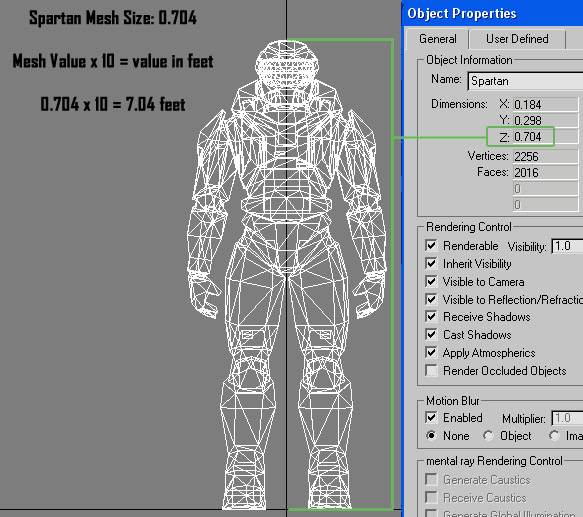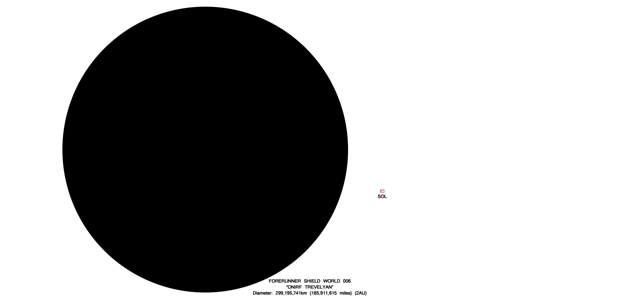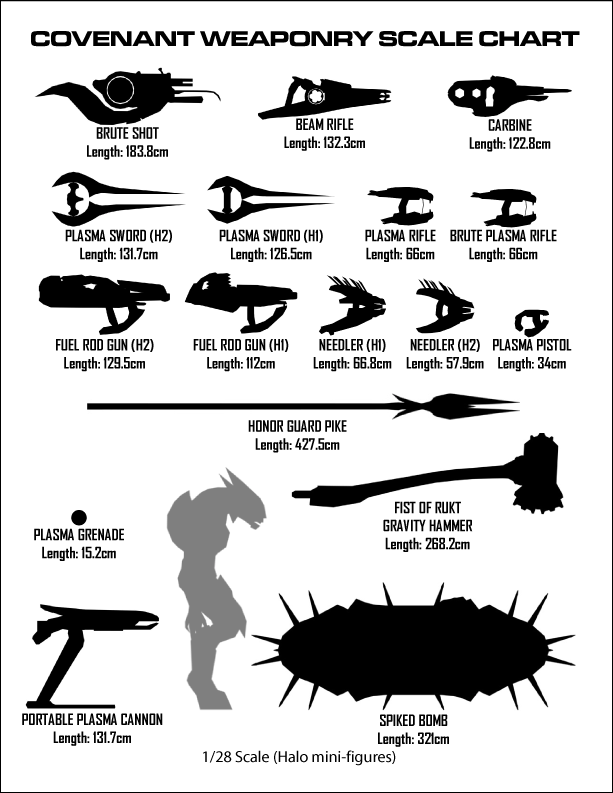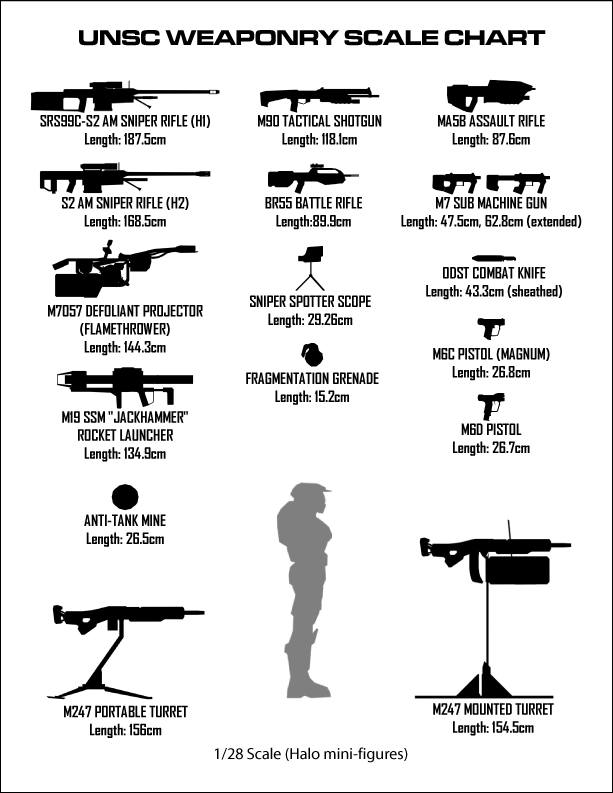Determining a system of measure
The folks at Bungie were smart in making well over 90% of the characters, weapons, objects, and environments in Halo: Combat Evolved a consistent and uniform scale. It makes determining the true sizes of items in the Halo universe a feasible endeavor. Most 3D programs can determine the outer boundaries of any object made or imported within them. In this example, the 3D program is 3D Studio Max. An arbitrary system of values are given to each object imported into the program. These numbers are consistent with each other with the notable exceptions listed later in this discussion.
Is this accurate?
Once we have access to numbers, they need to be made meaningful. To make them mean something in the real world, we need to at least have a definite value to calculate against. The easiest choice is the height given for the main character, Spartan-117. There are still debate as to how high John really is, but the most accepted value is around 7ft tall. We'll assume for this discussion that it's 7ft tall while he's in his armor.
Take a look at the following diagram. It's from 3D Studio Max and it shows the Spartan mesh and the related properties for it. The Z value is the most meaningful one for this discussion. According to that number, the Spartan mesh is 0.704 in height. What does that number mean? It's a number that tells us the mesh is that high in the vertical plane. It's helpful to game developers for ensuring that a character can walk through appropriately-sized halls and doorways by making them at least 0.704 or greater as well as other purposes. We need to turn that number into a meaningful value. If we were to multiply the number of the Mesh Value by ten, and called the resulting number a value measured in feet, then the Spartan mesh would be 0.704 x 10 = 7.04 (feet). That makes John just a hair over 7ft tall...that works for me! Ten may be an overly simplistic value. Perhaps it should be 10.06554 or something similar, but the point is just to get a number that allows us to translate meshes in the Halo universe into real numbers that are meaningful. As more cross-referencing is done, it becomes apparent that the 'ten factor' works for other sources as well. One that comes to mind is that the weapons for the Joyride Studios action figures are scaled to their figures the same way the mesh Marines have similarly scaled mesh weapons. The MA5B Assault Rifle is the same length whether you use this system to determine it's real world value or you just take a Halo action figure's AR, measure it, multiply by the figure's scale, and you'll get the same number.

Here's another example; the size of the Pillar of Autumn. In the diagram below, much like the Spartan mesh, we can see the three values of the outermost boundaries of the Autumn. The number that represents it's overall length is 384.064. Remember that both the Master Chief and the Pillar of Autumn are the same relative size to one another. So we have to use the same conversion number, ten. So 384.064 x 10 = 3840.64 feet. This is where it gets creepy. If we change the value to metric, 3840ft becomes 1.17km. Does the system work? Did Bungie intend the Autumn to be 1.17km long? Or is it just another coincidence of the number 117 showing up so frequently with them?! :)

Exceptions to the rule
There are only a few objects in all of Halo: Combat Evolved that are presented smaller than the intended scale. The reason is to save on computer and memory resources within the context of the game. The following are objects that are not scaled with everything else in-game:
- The Halo ringworld (full ring in space)
- Planet Threshold and its moon Basis
- The full version of the Truth and Reconciliation
It's obvious that a ring that's supposed to be 10,000km across is not going to be actually in the game at that size. You see Halo in its entirety on a couple of occasions; such as the view out the bow of the Pillar of Autumn's bridge viewport, and its destruction at the game's end. Halo's scale is internally consistent within itself, but it's not to scale to the other characters, vehicles and environments of the game.
Similarly, the Planet Threshold and its moon Basis are out of scale with everything else. Threshold and Basis, as 3D objects are seen as holograms in the Halo Control Center. The giant planet seen in the sky or in space is only a bitmap backdrop surrounding the environment you play in.
The Covenant Cruiser 'Truth and Reconciliation' is only seen whole on two occasions in the game. The first is in a self-titled chapter when the mission is to reach the ship's ground-side gravity lift. Cortana tells us that the ship is holding position 300m above the ring, but because the mesh has been scaled down it's actually much closer than that. There are two versions of the Truth and Reconciliation...the full ship, as seen above the mesa, and the part that's visible when you're on board and in the Covenant shuttlebay. The two ships are scaled differently by a factor of 2.5. The 'true' size should be the segment containing the shuttlebay, and therefore, all the other adjoining corridors and rooms. The smaller (full) mesh is likely just to save on computer resources again and as we don't get any closer to it than viewing it from the ground, it's real size and height in-game is hard to determine just by looking.
Conclusions
By determining a conversion factor to translate a mesh value into a known one, and having some known value by which it can be verified, the items, characters, vehicles, and locations in the Halo universe can be calculated.
The following charts are many of the ships, vehicles, and weapons from Halo. Each chart is consistently scaled to itself, and the small item on each chart becomes the basis of the one following so you can see the very large down to the very small. The formula determined above is used to obtain the values listed for each object. There are a few exceptions as I tried to logically place a few Halo 2 objects on the chart and determined their values through other scaling means, usually in reference to a known value. Suffice it to say, the Halo 2 objects will be corrected, if needed, as more information becomes available.
| 





